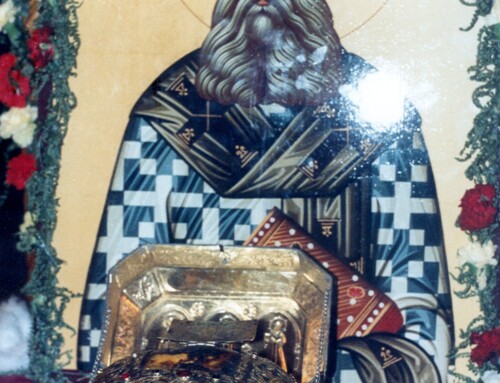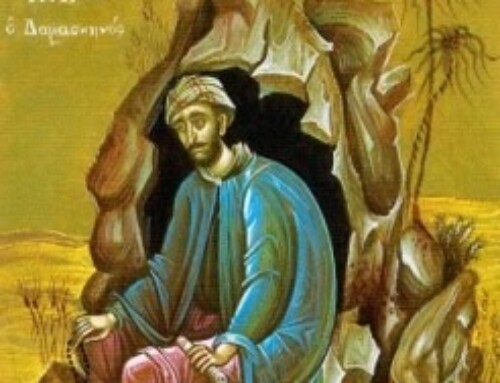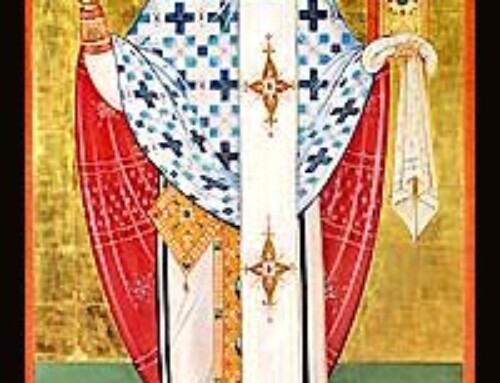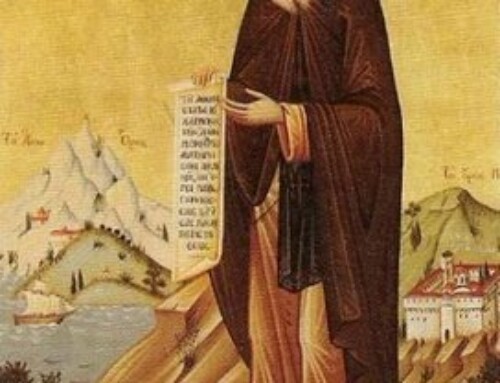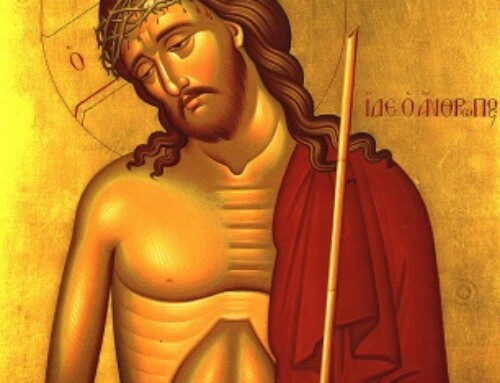Word Magazine September 1981 Page 11-12
TIME AND THE LITURGY
Another season has gone by, the summer is slowly leaving its hot, sweltering trail behind and autumn will soon fill its void with the crispness of the October air. Another autumn and school begins, the outdoors are clear and trees display their bright colored plumage. But shortly the wind becomes icy; the leaves fall to the ground and are covered by a blanket of winter snow. The chilly, gray months pass and finally spring comes to thaw us with its refreshing balmy breezes. We once again return to the still, breathless days of summer and the cycle of time has passed quickly completing yet another year. What is this seasonal circuit we are traveling, what is this cycle of time?
Time is the seconds, the minutes, the hours that fill our lives. We must be up at a specific time, wait for the bus at a particular hour, go to that mid-day dentist’s appointment, attend an afternoon class, make a reservation for that date, etc. Time is the content of our life as we fill it with our work and leisure. We wake and it is Monday, we are busy all week going to meetings, typing up reports, taking notes in class or tending to our business and soon with relief Friday is here. The weekend speeds by amidst our barbecues, day trips, and outings and all too soon it is Monday again, and the cycle starts anew. The rhythm continues endlessly week after week, year after year. Time is always in motion, never stopping for us. The clock keeps ticking and days pass. Time moves on efficiently, effortlessly, without emotion. It engulfs us and carries us unconsciously along its journey.
We look at the family photo album and it seems as if just yesterday we were that young teenager in the picture. Now we are graying, we have a few extra wrinkles and our movements are getting slower. The hours do not stop for those moments we want to savor but continue leaving faces, friends, and loved ones far behind. Time causes our memories to grow feeble, our bodies to grow frail and it strikes fear in us as we look into the dark expanse of the future. The hours, days and seasons plod along rhythmically, steadily, until we reach the end and still time does not stop but leaves our bodies strewn along the path as it continues its journey.
The question of time poses an interesting problem. For when the thousands of books have been read, when all the theories have been proposed, when the accumulation of wealth has been made and the many friends have been known, one is still confronted with the very last question of time and its ultimate finality. Many have attempted to answer this question.
The ancient Greek philosophers adopted a ‘cyclic’ view of history. Plato stated the obvious in expounding on his concept. He said that time moves in a circle without a beginning or an end, but is constantly going around in repetition, like the rising and setting of the sun each day. The repetition of the seasons and even the movement of the stars annually in the heavens was a symbol of this circle. In our own life events are repeated over and over again. We are constantly faced with the same problems, our goals always end up with the same results, our relationships always turn out the same, our displeasing habits remain unchanged. Life is lived in a circular rut, in a state of sameness and paralysis, going nowhere but merely repeating itself. For Plato the only way one could escape this hopeless circle of duplication was through death. For through death the soul of man could be released from its cumbersome covering of flesh and from the entrapment of this grim world.
Another more optimistic view of time and its meaning stemmed from a different source. For, “In the beginning God created the heaven and the earth . . . “(Genesis). The Semitic concept of time explained that God created all existence out of nothing. Hence God was not only the Creator of life but of time also. Judaism had a very different philosophy of history from that of the Greeks. Where Plato saw only a closed circle endlessly repeating itself, the Jew saw an historical line. This initial point of linear time started with the first six days of creation. In those beginning days, God created the heavens, earth, water, vegetation, animals and the crown of all His activity occurred on the sixth day when He brought forth man:
“Let us make man in our image, after our likeness and let him have dominion over all . . . “ The labor of God was completed, man was in Paradise, all was perfect and on the seventh day, the Sabbath, God and all creation rested. The Sabbath was beyond time in its perfection, man lived in innocence and contentment, contemplation and peace.
But man was shocked out of his perfect inertia and the timeless presence of God. Through his free will and rebellion man became a slave not only to his passions but to the hopeless finality of time. Hence the historical journey of man continued. We read in the Bible the history of the Patriarchs, Kings and Prophets. The annals of the Hebrews in the Old Testament show us that time was moving in a line with a beginning and an end, an expectation and a fulfillment. From slavery in Egypt to freedom, from the wanderings in the desert to the covenant on Mt. Sinai, from a band of unruly nomads to one of the most powerful kingdoms of antiquity under Solomon, this history shows that God did not abandon man but was bringing him from hopelessness to hope.
Perhaps the greatest age of hope came when the situation looked bleakest, in the age of the prophets. When Israel was exiled to a foreign land, when the Temple of Jerusalem was in ruins, the prophets proclaimed an even greater vision. This was the period of time when all expectations would be fulfilled, when all motion of time would come to its true meaning. This new expectation was the “Day of the Lord,” a time when the people would no longer mourn, would no longer live in fear and pain, would no longer live in hopelessness. The Day of the Lord was a desire which filled the life of the people forevermore.
History has taken us up to today, the age of enlightenment, of modernism, of scientific thought. Here we have many views of time and its finality. For the modern philosopher, life ends in “nothingness”, in absurdity. For the scientist, life ends precisely when the blood stops flowing to the brain. But we know that there is more than this definition, there is more than the exactness of cold facts, for it is something that we feel in our heart, that which strikes the very depths of our soul.
For example we can view the face of the clock on the wall and observe the minute hand forever, we will view the endless movement, the ticking, the numbers, but still it makes no sense to us. We know that it is a mere invention of man which somehow tries to contain the elusiveness of time. We sense there is more. We know that time speeds by too quickly when we are with someone we love. The hours fly by like seconds as the loved ones feel the warmth of each other’s presence. The encounter is over too quickly but the memory lasts forever. Conversely if we are waiting for a bus in cold weather, sitting in a very dull lecture class, or waiting for the next meal when we are very hungry, the minutes go by too slowly and it seems like hours, as if the situation will never end.
Our time on the face of the clock is a desperate illusion. Our time is a product of our limited nature which cannot express the fullness of reality known by our heart and soul. For we understand with our finite mentality the past, present and future but we cannot understand the infinite time of God known by our soul. That span which is like the tide of the sea, the vastness of the stars at night, it is that which is eternity, where the past, present and future are suspended into one entirety.
At the beginning of the Divine Liturgy the deacon and the priest have a short dialogue. The deacon says, “It is time, Master.’’ What is this time? ‘‘In the fullness of time God sent His only begotten Son . . . “ The fullness of time was upon us for the Creator of all communed with His creation. The yearning, desire, hopes and prayers of man were moving from its expectation to its fulfillment. No more were we to be trapped in the endlessness of circular time; no more to live from one disfigured Sabbath to another, for the “Day of the Lord” is upon us. The Sabbath, the seventh day in which God rested before man’s fall has been restored by a “new” time. God granted us an eighth day of creation, a “recreation” of the entire world in Christ.
The Day of the Lord is here, “The kingdom of heaven is upon you.” There is no more despair about our imminent finality, the world is not to be loathed, life is not absurd, life does not end in nothingness, for Christ has come. All time has been shattered in He who is the beginning and the end, for we now live in the timeless presence of God.
The liturgy is the symbol which unites the fullness of time back to its completeness, its wholeness. This is the meaning of the time which the deacon refers to when he comes to the priest. For the liturgy is the new time, it is the gift to the world; it is the kingdom of heaven which is upon us now. Thus Sunday is forever the Day of the Lord, that day of the liturgy when we commemorate not an historical event of a man that lived two thousand years ago, neither a colorful religious rite, but it is the movement, the entry into this new time of hope, recreation and resurrection which transforms our life and the entire world.
We begin the liturgy in the presence of the living God. This time which for us is no longer a desire but a reality is expressed in the opening prayer, “Blessed is the kingdom . . .“ No longer do we live in the state of despair but we have moved into the kingdom, we are kings who have entered into the fullness of our domain. We respond with the ancient reply, “Amen,” (So be it). And so we confirm this reality with our words, with our heart, with our entire being. No longer are we left distraught in the pain of life and its finality for we have become enlightened, illumined and transformed into the time of God.
Steven Adams is a student at St. Vladimir Seminary in New York and wrote this article exclusively for The Word.

